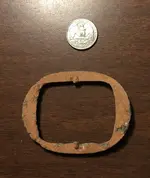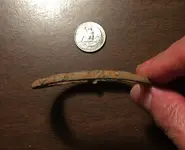GlowingGem asked:
> How do you know it is "white metal"?
Tcndig used the Metallurgical name "White-Metal," which means any of several varieties of non-precious (and therefore inexpensive) silvery-looking metal alloys. The cheapest of them all is "Pot-Metal," so named because it originated as leftover foundry scraps of Tin, Zinc, Lead, Antimony (etc.) all tossed into the melting pot together to produce cheap metal objects. A manufacturer who wants to cut costs will use Pot-Metal instead of making brass buckles, because brass contains copper, which is far more expensive. (It is used as money, y'know.)
We know with certainty that this excavated buckle is made of White-Metal, and more specifically Pot-Metal, because of the distinctive type of corrosion we see on it. Notice that in all three photos this buckle's patina shows scaling and "pocketing," with bits of white scattered among the grey oxide. That "look" is a characteristic of zinc corrosion, and zinc is usually a main ingredient in Pot-Metal.
> This is an extremely common buckle shape likely still being made today.
That is correct. The usage of Pot-Metal for cheap belt buckles became more and more common as the 20th Century progressed. Therefore, although this buckle COULD be from the early 20th Century, I think it is "statistically" more likely to be from somewhat later. (I wore one just like it, mass-produced when 2-inch-wide leather waistbelts became popular among the hippies in the 1960s/70s.)






